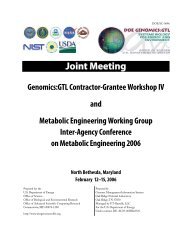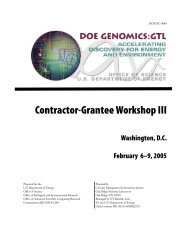Joint Meeting - Genomics - U.S. Department of Energy
Joint Meeting - Genomics - U.S. Department of Energy
Joint Meeting - Genomics - U.S. Department of Energy
You also want an ePaper? Increase the reach of your titles
YUMPU automatically turns print PDFs into web optimized ePapers that Google loves.
18<br />
Systems Biology for DOE <strong>Energy</strong> and Environmental Missions<br />
20<br />
Thermophilic Electricity Generating<br />
Bacteria as Catalysts for the<br />
Consolidated Bioprocessing <strong>of</strong><br />
Cellulose<br />
T. Shimotori, 1 C. Marshall, 2 R. Makkar, 2 M. Nelson, 1 and<br />
H. May 1,2 * (hmay@mfctech.net)<br />
1MFC Technologies, LLC, Mount Pleasant, South<br />
Carolina and 2<strong>Department</strong> <strong>of</strong> Microbiology and<br />
Immunology, Medical University <strong>of</strong> South Carolina,<br />
Charleston, South Carolina<br />
Project Goals: Discover thermophilic electrode<br />
reducing bacteria that may be used with cellulolytic<br />
and ethanologenic bacteria to convert cellulose into<br />
bi<strong>of</strong>uels. Apply aforementioned bacteria in modified<br />
fuel cells for the production <strong>of</strong> ethanol, electricity and<br />
hydrogen (or combination there<strong>of</strong> ) from cellulose.<br />
The biological mediation <strong>of</strong> the conversion <strong>of</strong> lignocellulose<br />
to bi<strong>of</strong>uels holds much promise, particularly when<br />
regarding the supply constraints and contribution to<br />
global warming associated with fossil fuels. Consolidated<br />
bioprocessing <strong>of</strong> cellulosic biomass leverages the catalytic<br />
activity <strong>of</strong> cellulolytic and ethanologenic bacteria to<br />
produce ethanol 1,2 . Due to their rapid and effective ability<br />
to metabolize cellulose, the bacteria utilized in this<br />
process are thermophilic, e.g. Clostridium thermocellum<br />
and Thermoanaerobacter thermosaccharolyticum. However,<br />
the formation <strong>of</strong> acetate and other by-products during<br />
the processing and fermentation <strong>of</strong> plant biomass is<br />
common, which may inhibit the overall fermentation.<br />
Therefore, it would be advantageous to use bacteria<br />
capable <strong>of</strong> consuming acetate in combination with the<br />
cellulolytic bacteria. One clever way to consume acetate<br />
under anaerobic conditions is to use electricity generating<br />
bacteria and microbial fuel cells (MFCs), where acetate<br />
is converted to carbon dioxide and electricity is generated.<br />
A thorough description <strong>of</strong> MFCs is given in a new<br />
book authored by Bruce Logan 3 . We set out to discover<br />
thermophilic electricity generating bacteria that would be<br />
compatible with the thermophilic ethanologenic bacteria<br />
with the idea that ethanol and electricity could then be<br />
generated from cellulose.<br />
To find thermophilic electricity generating bacteria we<br />
enriched for acetate-consumers in MFCs beginning with<br />
sediment fuel cells from marine and freshwater sources<br />
incubated at 60°C. This population was further enriched<br />
in sediment-free single chamber fuel cells equipped with<br />
air cathodes. Following several exchanges <strong>of</strong> the media<br />
* Presenting author<br />
SBIR<br />
and several transfers to additional fuel cells with only acetate<br />
as an energy source, the enriched community from<br />
Charleston Harbor was scraped from the surface <strong>of</strong> an<br />
anode and the 16S rRNA genes <strong>of</strong> the community were<br />
cloned and sequenced. A mixed community that included<br />
bacteria most closely related to Deferribacter spp. but<br />
dominated by Gram positive Firmicutes, particularly <strong>of</strong><br />
Thermincola spp., was discovered. The Deferribacter spp.<br />
have been isolated from deep wells and deep-sea hydrothermal<br />
vents and some species are known to reduce<br />
metals external to the cells 4-6 . Two Thermincola spp. have<br />
been isolated from volcanic hotsprings 7,8 . Interestingly,<br />
our community came from a mesobiotic estuarine harbor.<br />
Spores from the Thermincola are resistant to autoclaving,<br />
and our enriched community would still grow and<br />
generate electricity in a fuel cell supplied with acetate<br />
even after the inoculum was autoclaved for 30 minutes.<br />
The 16S rRNA genes <strong>of</strong> the autoclaved community are<br />
now under analysis. In addition, T. ferriacetica, which is<br />
capable <strong>of</strong> reducing insoluble iron oxides while consuming<br />
acetate, is in pure culture and we are now testing it<br />
for the ability to generate electricity in a fuel cell. Both<br />
the enriched community and T. ferriacetica are also being<br />
tested in combination with cellulolytic bacteria, e.g.<br />
C. thermocellum, in a consolidated bioprocess to produce<br />
ethanol and electricity from cellulose.<br />
References<br />
1. Lynd, L.R., van Zyl, W.H., McBride, J.E. & Laser,<br />
M. Consolidated bioprocessing <strong>of</strong> cellulosic biomass:<br />
an update. Curr. Opin. Biotechnol. 16, 577-583<br />
(2005).<br />
2. Lynd, L.R., Wiemer, P.J., van Zyl, W.H. & Pretorius,<br />
I.S. Microbial cellulose utilization: fundamentals<br />
and biotechnology. Microbiol. Mol. Biol. Rev. 66,<br />
506-577 (2002).<br />
3. Logan, B.E. Microbial Fuel Cells. Wiley-Interscience<br />
(2008).<br />
4. Miroshnichenko, M.L. et al. Deferribacter abyssi<br />
sp. nov., an anaerobic thermophile from deep-sea<br />
hydrothermal vents <strong>of</strong> the Mid-Atlantic Ridge.<br />
Inter. J. Syst. Evol. Microbiol. 53, 1637-1641 (2003).<br />
5. Takai, K., Kobayashi, H., Nealson, K.H. & Horikoshi,<br />
K. Deferribacter desulfuricans sp. nov., a novel<br />
sulfur-, nitrate- and arsenate-reducing thermophile<br />
isolated from a deep-sea hydrothermal vent. Inter. J.<br />
Syst. Evol. Microbiol. 53, 839-846 (2003).<br />
6. Greene, A.C., Patel, B.K. & Sheehy, A.J. Deferribacter<br />
thermophilus gen. nov., sp. nov., a novel thermophilic<br />
manganese- and iron-reducing bacterium<br />
isolated from a petroleum reservoir. Int. J. Syst. Bact.<br />
47, 505-509 (1997).





